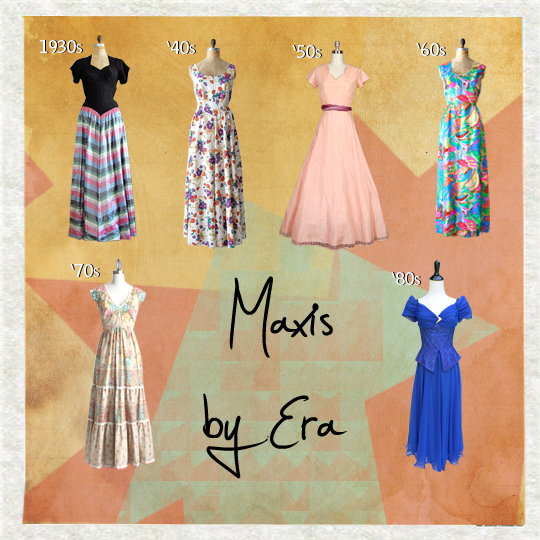
Identifying the era of a vintage maxi dress is not an easy task!
As a vintage style lover or seller, you already know what maxi dress patterns you enjoy most and how to style a vintage maxi so that it’s wearable for everyday contemporary chic.
But when it comes to knowing the decade the dress was made and the historical styles it represents, you’re a little lost.
But that’s OK! To help you learn, I created this easy-to-read guide to everything you wanted to know about identifying a vintage maxi dress by the era.
Whether you purchase your vintage maxi while vintage shopping, flea market hopping or thrift store shopping your favorite local haunt, this guide will help you to accurately authenticate an era’s maxi so you can speak vintage like a pro!
Keep reading after the jump to learn just what a ’30s, ’40s, ’50s, ’60s, ’70s and ’80s maxi dress looks like and to vote for your favorite era in the poll at the bottom of this article!
1970s clothing is my favorite era to wear right now, so admittedly I’m partial to ’70s dresses of the maxi length style.
What’s your favorite decade for maxi dresses?
Let me know by voting in the poll at the end of this article or by ending me a Tweet, following me on Instagram or saying hello on Facebook!
xx, SD
1930s Maxi Dresses
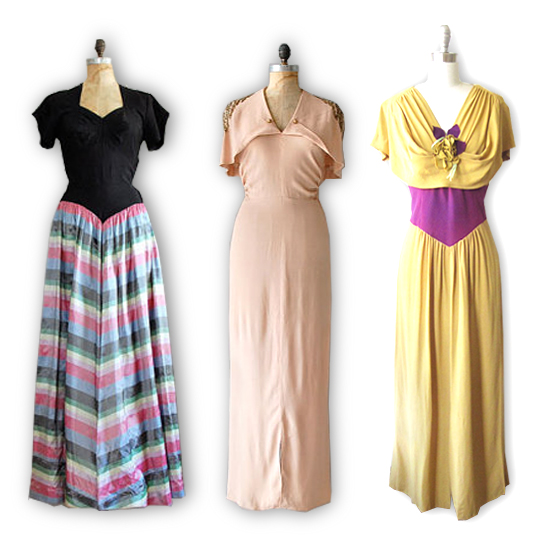
Grandstand Stripe Maxi – $225 / Temple of Luxor Maxi – $545 / Mustard Yellow & Purple Maxi – $265
Solid-colored and decorative at the neck maxi dresses with a natural or empire waist were most popular.
The ’30s Era
Depression-torn, poverty-stricken time that started with the stock market crash in 1929 and ended with the US entrance into World War II in 1941.
Extravagance took a backseat, replaced by the more common practice of wearing costume jewelry to feel glamorous and even the innovative practice of transforming material used from feedsack cases into a vintage version of today’s “up-cycled” dress.
Women wore day suits and day dresses ’round the clock that were fashionable but functional for 24/7 affairs, versus the ’20s and ’40s when women may have changed their clothing between day and night.
How To Know It’s ’30s
Woven using crepe (artificial silk) fabric. This material had a wave-like texture that in comparison to production methods today, gives these dresses their top-quality allure.
Solid muted colors. Bright shades and intricate designs were few and far between. This spoke to both the demure mood of the time and also the production methods available.
Decorative necklines. Oversize collars and unique necklines (with stylized cuts and draping) and treatment like applique, buttons and trim were standard on a ’30s day dress, and not just reserved for special occasion pieces.
1940s Maxi Dresses
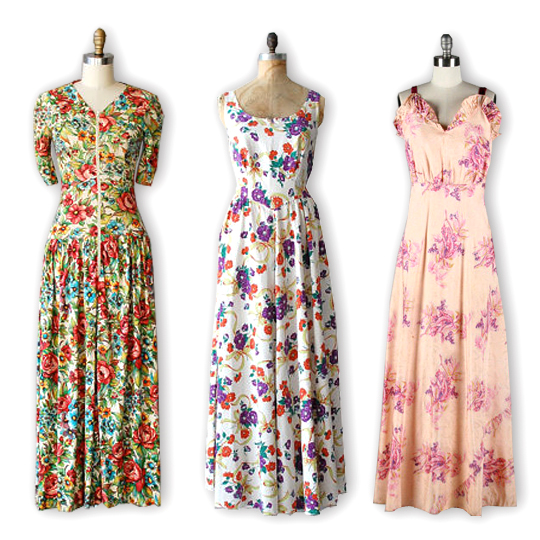
Vizcaya Garden Maxi – $178 / Mikura Floral Dress – $178 / Peach Floral Maxi – $125
Floral pattern maxi dresses with a simple shape and limited adornment were the most popular.
The ’40s Era
World War II lasted from 1941 through 1945.
The war’s influence on fashion lasted about half the decade. The trends of the first half versus the second half of the ’40s are quite different stylistically speaking.
A woman’s work changed the way she dressed in the ’40s. With so many American men fighting the war, approximately 4 million women entered the workforce for the first time. A woman was thus wearing her dresses and skirts less often, and was even seen wearing a pair of trousers or two.
How To Know It’s ’40s
Made from artificial silk “rayon.” Popular because silk was prohibited for the manufacturing of clothes during the war.
Brights, florals or novelty print. Dresses were more simple in design, so they made up for it in print.
Limited trim, applique and buttons. Decorative details were scarce because of war rations and encouragement to do “less with more” in fashion as patriotic expression.
1950s Maxi Dresses
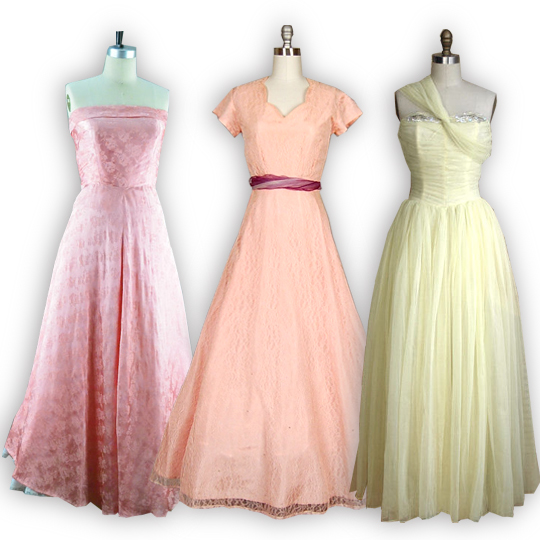
Coral Pink Maxi Gown – $56 / Pretty-in-Pink Maxi Gown – $120 / Lemon Yellow Maxi Gown – $198
Prom-style maxi “princess gowns” made from tulle and chiffon in pretty pastel hues were most popular.
The ’50s Era
Suburbia was born and with it the nuclear family, innovations in technology and thanks to a stable economy, disposable income to spend on leisure and play.
The circle skirt “prom” tulle gown as worn by Elizabeth Taylor in 1951’s “A Place in the Sun” became the most popular dress replica of its time.
Women wore girdles, corsets, corseletes and other body enhancing undergarments to firm, contour and tighten for the best (not to mention skinniest!) fit possible in the era’s body-conscious garments.
How To Know It’s ’50s
Made from tulle and chiffon. A lining of crinoline was worn below the skirt to give it the fullest effect possible.
Pastel colors or simply a dark hue of brown or black. The brights of the psychedelic ’60s were still a decade away!
Halter styles for a bare shoulder look. With all that coverage below, at least a little bit of skin needed to show, after all.
1960s Maxi Dresses
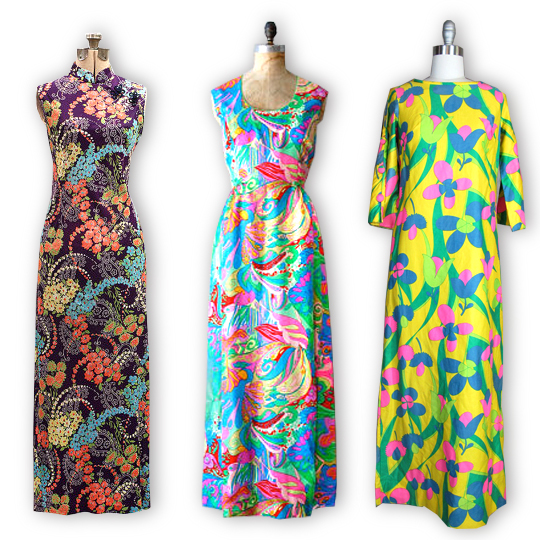
Wild Orchard Maxi – $38 / Magic Lilypond Maxi – $124 / Bold & Bright Floral Maxi – $45
Psychedelic, brightly-colored floral “flower power” maxi dresses were most popular.
The ’60s Era
Known as the “swinging sixties,” it was an era marked by change and growth, including the civil rights movement, the death of social rights leaders (John F. Kennedy, Martin Luther King, Jr and Malcolm X) and the landing of man on the moon are just a few examples.
Styles shifted significantly in mood from the early to the late ’60s. The decade is therefore difficult to define under one catch-all trend and is better described broken into the periods of early, mid and late years. Mad Men ’60s styles represent the early to mid ’60s, for example.
The first maxi dress appeared on the runways in 1967, and the style was adopted by the mainstream toward the end of the era when psychedelia patterns were trendy.
How To Know It’s ’60s
Acrylic, linen, cotton and sometimes polyester. While most maxis of the ’70s were made from polyester, a maxi from the ’60s is less likely to be constructed from this fairly inexpensive material because they were more often handmade from higher quality fabrics.
Patterns are eye-catching designs. Bold and wild florals, abstract art motifs, op art designs and trippy paisley were used as all-over-prints to cover 100 percent of the dress.
Workmanship is top quality. Constructed with metal zippers, hook and eye closures or snap buttons, whether handmade or by ready-to-wear designers that still made pieces with quality craftsmanship not comparable in value to modern equivalences.
1970s Maxi Dresses
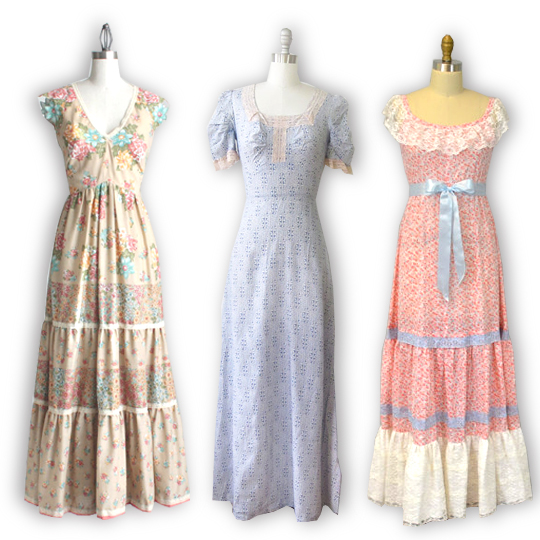
Victor Costa Prairie Dress – $125 / Blue Puff Sleeve Prairie Dress – $58 / Red Floral Prairie Maxi – $85
Prairie, peasant and western style maxi dresses with ’30s-inspired prints and Victorian/Edwardian lace treatment were most popular.
The ’70s Era
Political and culture strife surrounding the Vietnam War, coupled with America’s growing understanding of the negative effects of its resource-sucking globalization on the planet continued to perpetuate the hippie mantra of “Peace, Love, Brown Rice” that grew into the “Flower Child” movement of the era.
Fashion adopted the Earth-loving ethos of ’70s counter culture so that styles reflected more simple times thanks to 1930s influences, design with natural materials (leather, wood, suede) and participation in the sustainable aspects of secondhand fashion.
The 1970s was THE decade of the maxi dress. After the ’60s mini skirt revolution, the hem dropped from mid-thigh to ankle-length for a more relaxed, “natural, earthy” look than what the sexually liberated styles of the Swinging Sixties encouraged.
How To Know It’s ’70s
Cotton and polyester blends were the most popular materials. For prairie dresses, cotton dresses with eyelet lace trim was the definitive style.
’30s-inspired ditzy (tiny) floral prints. Patterns look like fields of flowers you’d find in the frontiers of the Great American West. Country-rustic prints calico, gingham and paisley are also frequently seen.
Eyelet lace trim or all-over treatment. Lace was a big trend on maxi dresses in the ’70s because it was reminiscent of the Victorian and Edwardian eras, which were influential periods for ’70s designers.
1980s Maxi Dresses
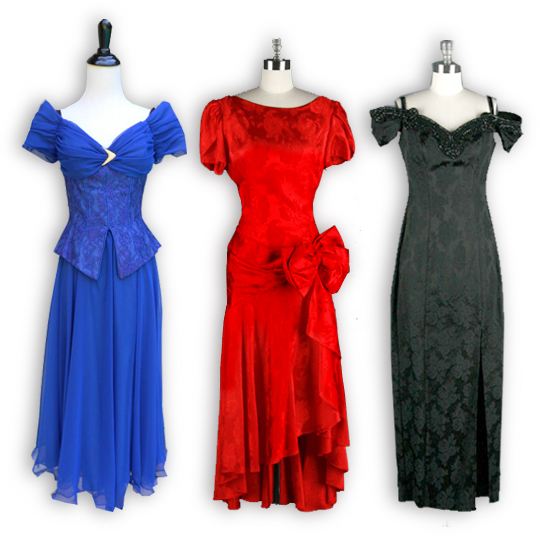
Lady Sings the Blues Maxi – $58 / Lady in Red Maxi & Back in Black Maxi – Rustyzipper.com
Styles for formal functions with exaggerated shoulders and necklines reminiscent of ’40s style and ’50s fit were the most popular.
The ’80s Era
The early ’80s was defined by a grim economy as American production was increasingly outsourced to cheap manufacturing hubs like China, Korea and Taiwan. A global economic crisis set in most of the developed world. Under the Reagan administration, the US continued to battle the Cold War through 1991.
The decade took style inspiration from trends of the war-torn ’40s and the golden ’50s. A female’s shoulders were bigger (shoulder pads!) as inspired by the ’40s, and a typical ’80s dress embraced a women’s curves with hip and bodice hugging fits.
More women than ever were entering the workforce and so a women’s standard dress shifted significantly from the pretty prairie dresses of the ’70s to strong, sexy and secure styles for the ’80s.
How To Know It’s ’80s
Produced in countries like China, Korea and Taiwan. While some clothing production remained onshore in the ’80s, seeing an Asian country on a piece’s interior tag was a key sign of the times.
Exaggerated sized, decorative shoulders and trim along the neckline. Shoulder pads, puff shoulders and embellished necklines mark the decade’s general design best. Bigger and bolder was better!
Funky formal wear styles. Typical clothing for women had transitioned from day dresses and knee-length skirts to pants, jumpsuits and the oversize sweatshirt with leggings trend for the ’80s trendsetter.
MORE VINTAGE MAXI DRESSES
INSPIRATION: Stylish Thought Accessories a ’70s Maxi Dress 3 Ways
PATTERNS: 18 Unique Maxi Dresses for Every Print Personality
VIDEO: Shopping for a Maxi Dress at the Manhattan Vintage Show!
LOOKBOOK: ’70s Maxi Dresses Wearable for Spring 2012
SHOP: All the Vintage Maxi Dresses You’d Ever Want!

I love clothes from the 40’s.
It was fun to see clothes from the diferent areas.
The ’40s is fab, isn’t it? Thanks so much for reading and commenting, Ruth! Do you own any vintage pieces from the 1940s? xx
Hi Sammy,
Thanks for tha article. I have difficulties telling which era the vingate clothes that I buy belong to.
I adore the 40s and 70s. Yesterday I went to a thrift store in my lunch break here in Varna. Guess what, everything was 50% off of already rediculously discounted items. I got a very pretty flower maxi dress from the 70s (now that I have read the article I can tell :). It was only 1,5 BGN, which is about $1. Along with that I got an adorable maxi skirt for $1 as well, it was vintage YSL, total score!
Regarding the maxi dresses, I love flower pirints, lace, bows, just anything that’s feminine and romantic. At the same time I love confy clothes, cotton, linen, silk.
Thanks again, as it would help me better determine the decade.
Dobs
Dobs, what a beautifully thoughtful comment on this article. Thank you so much for reading it and taking time to comment. That is so great that you had a 50% off day! Score! VINTAGE YSL?! Thrift Gods blessing!!
I’m all about comfy clothes, too ;-) That’s why out of all the eras I prefer the ’70s. Let is flow, baby!
Thank you again Dobs. Keep spreading vintage love!
Great post!
I love 60’s dresses, but if I could actually find ones from the 40’s they’d become my new favorites!
This is great news!!! Do you own a ’60s maxi already Miss E? xx
Nicely done breaking down the era’s Sammy…and with a visual component too! I am a 50’s girl.
hey Stephanie! Yes you are!! I’ll stop staring now ;-) XO vintage love sister
hi sammy i have a vintage dress that does not have a label and i really want to know what era is from, could i send a picture to you ? to see if you can identify it.
i would greatly apreciate it
thank you so much!
would love a picture! email away! [email protected]